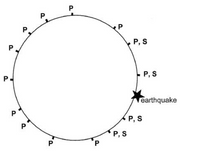Question
27) The figure below shows a cross section of a hypothetical planet. An earthquake occurred near the surface and seismometers recorded the arrival of P- and S-waves as shown in the figure. The waves shown are the first arrivals and have NOT been refracted or reflected. What can you conclude about the interior of the planet based on seismographs?
A) The boundary between the lithosphere and asthenosphere is close to the surface
B) The planet has a large, liquid core
C) The planet has a large, solid core
D) The planet has a solid inner core

Transcribed Image Text:P
P, S
P, S
P-
earthquake
P
P, S
P
P, S
"P
P.
Expert Solution
This question has been solved!
Explore an expertly crafted, step-by-step solution for a thorough understanding of key concepts.
This is a popular solution
Trending nowThis is a popular solution!
Step by stepSolved in 2 steps

Knowledge Booster
Similar questions
- 3. Several years ago, NASA conducted the Lunar CRater Observation and Sensing Satellite (LCROSS) mission to look for evidence of water deep in craters near the south pole of the Moon (www.nasa.gov/mission_pages/LCROSS/main/index.html). Preliminary analysis of the LCROSS data has already demonstrated that there are indeed signifcant quantities of water on the Moon-a useful thing to know if we ever decide to build a permanent base on the Moon. The LCROSS spacecraft was launched from Earth aboard at Atlas V rocket on 18 June 2009. It was then sent on its way to the Moon by a Centaur transfer stage rocket. On 9 October 2009, while being observed by the LCROSS spacecraft, the Centaur rocket crashed into a crater at the south pole of the Moon creating a huge plume of Lunar dust. Instruments on the LCROSS spacecraft measured the spectroscopic properties of this dust and radioed this data back to Earth for analysis. Then, 4 minutes after the Centaur rocket impacted the Moon, the LCROSS…arrow_forward21) Why doesn't Venus have as many craters as Earth's moon?arrow_forward5) Why doesn't Earth have as many craters as the moon?arrow_forward
- Tutorial An earthquake occurs 7,375 km from a seismograph. The P-waves arrive 12.2 minutes later. How fast is the P-wave traveling (in km/s)? If the lag time between P- and S-waves is 10.6 minutes, how fast are the S-waves traveling (in km/s)? Using the shadow of S-waves you determine that the radius of the core is 55% of the Earth's 6,378-km radius. How many kilometers from the surface is this (in km)? Part 1 of 3 To calculate how fast the P-waves are traveling, we need to divide the distance the waves travel by the time. d Vp = Make sure you are dividing by the time in seconds. s Vp = Make sure you are dividing by the time in seconds. km/sarrow_forwardWhat is remanent magnetism? How can it be used to track the movement of continents over time?arrow_forward#54arrow_forward
arrow_back_ios
arrow_forward_ios